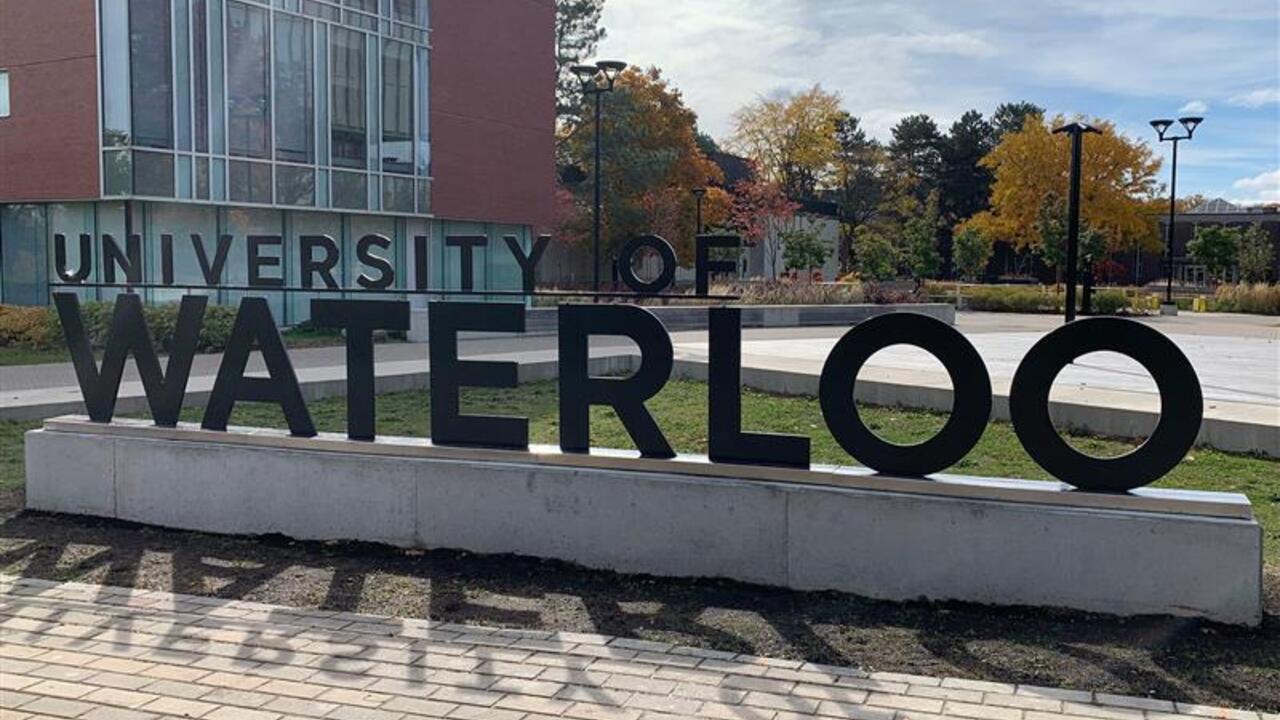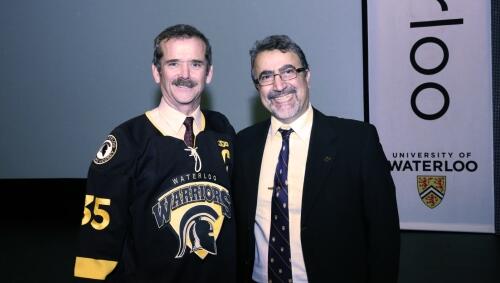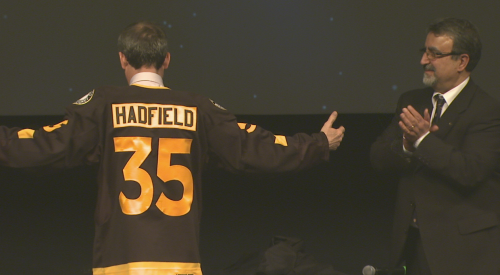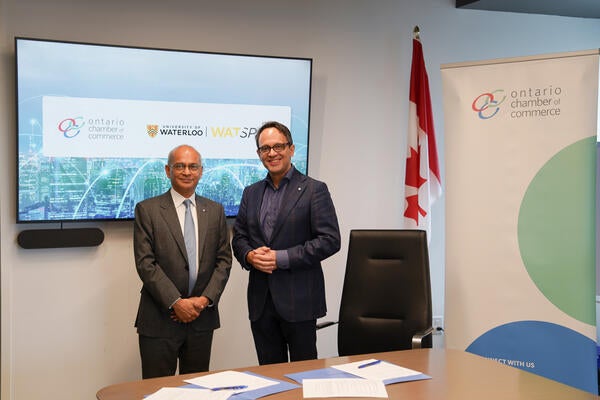
Professor Chris Hadfield calls world class University home
Professor Chris Hadfield addressed a crowd that came to hear his free public lecture at the University of Waterloo today.

Professor Chris Hadfield addressed a crowd that came to hear his free public lecture at the University of Waterloo today.
By Media RelationsKeep your long-term goals in mind to make your dream a reality, Professor Chris Hadfield told members of a capacity—and captivated—crowd that came to hear his free public lecture at the University of Waterloo today.
“You don't get lost in the hassles of the short term. It helps you keep your decision-making headed in the right direction,” said Professor Hadfield, who dreamed of going to space before Canada had an astronaut program. “Nothing in the future is guaranteed. But what is a guarantee is if you don’t turn yourself into the person you want to be, you zero your own chances."

Professor Hadfield and Professor Feridun Hamdullahpur
Professor Hadfield, who has been around the world 2,500 times, took the audience on an astronaut's trip around the Earth, from launch to re-entry. The lecture was his first appearance on campus since his appointment as adjunct professor of aviation last October.
He is cross-appointed to the Faculty of Science, Faculty of Environment and the Faculty of Applied Health Sciences, and will assume some teaching and advising responsibilities in aviation and related programs at Waterloo in the fall of 2014. Waterloo's bachelor of science and bachelor of environmental studies programs both offer coursework in aviation.
"It's astonishing to think that I once introduced Chris Hadfield to a Waterloo audience as he orbited the Earth on the International Space Station," said Feridun Hamdullaphur, president and vice-chancellor of Waterloo. "I welcome him here today as a member of our faculty. This is an exciting day as he gives his first lecture as professor."
During his five months in space, Professor Hadfield participated in two ongoing research projects related to cardiovascular health with Professor Richard Hughson, of the Department of Kinesiology. One study is investigating why some astronauts are prone to fainting spells when they return to Earth. The other is looking at why arteries undergo aging-like changes during spaceflight, and whether the results have direct application to the major health problems associated with stiffer arteries as we age.
Professor Hadfield underwent the latest in a series of tests as part of Professor Hughson’s research to measure the thickness of the arteries in his neck following today’s lecture. Today’s experiments follow tests Hadfield last underwent on the day he landed back on earth.
Waterloo's aviation program launched in 2007. It is the first to offer a bachelor of science degree in Aviation with a specialization in physics or earth sciences or non-specialized science with geomatics. It also offers the first bachelor of environmental studies in geography with a geomatics specialization that also allows students to graduate with a commercial pilot license.
Specific details with respect to his courses, research and advising are still being reviewed, but it is anticipated that Professor Hadfield will give lectures in existing aviation courses ranging from flight management to human factors in aviation.
"This university is absolutely world class," said Professor Hadfield. "I'm really looking forward to coming back in the fall. That will be when the circle comes around and I feel that my feet are back on the ground."
Following his lecture, Professor Hamdullahpur presented Professor Hadfield with a Waterloo Warriors hockey jersey that bears his name. Then Professor Hadfield signed copies of his book, An Astronaut's Guide to Life on Earth, for the more than 200 people who waited in line for a chance to meet him.

Professor Hadfield wears a Waterloo Warriors hockey jersey on stage after his public lecture
Professor Hadfield’s relationship with the University of Waterloo dates back to 1982 when he undertook post-graduate research here. Professor Hadfield, who made a space-to-campus downlink call to Waterloo students Feb. 15 this year — he was 370 kilometres over the Earth at the time — gave the keynote address when the university launched its aviation program in 2007.
In just half a century, the University of Waterloo, located at the heart of Canada's technology hub, has become one of Canada's leading comprehensive universities with 35,000 full- and part-time students in undergraduate and graduate programs. Waterloo, as home to the world's largest post-secondary co-operative education program, embraces its connections to the world and encourages enterprising partnerships in learning, research and discovery. In the next decade, the university is committed to building a better future for Canada and the world by championing innovation and collaboration to create solutions relevant to the needs of today and tomorrow. For more information about Waterloo, please visit www.uwaterloo.ca.
-30-
Nick Manning
University of Waterloo
519-888-4451
226-929-7627
Pamela Smyth
University of Waterloo
519-888-4777
www.uwaterloo.ca/news
@uWaterlooNews
Attention broadcasters: Waterloo has facilities to provide broadcast quality audio and video feeds with a double-ender studio. Please contact Nick Manning on 519-888-4451 or 226-929-7627 for more information.

Read more
President of Waterloo EDC says the University of Waterloo plays a pivotal role in region’s economic development on the global stage

Read more
The faculties of Science and Arts introduce a new theatre and performance course tailored to Science students

Read more
Waterloo’s WatSPEED to provide businesses with access to AI upskilling programs in new province-wide initiative
The University of Waterloo acknowledges that much of our work takes place on the traditional territory of the Neutral, Anishinaabeg and Haudenosaunee peoples. Our main campus is situated on the Haldimand Tract, the land granted to the Six Nations that includes six miles on each side of the Grand River. Our active work toward reconciliation takes place across our campuses through research, learning, teaching, and community building, and is co-ordinated within the Office of Indigenous Relations.